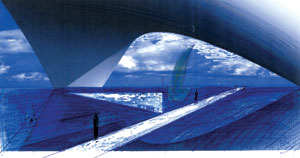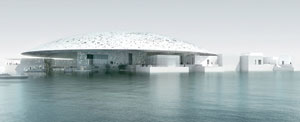Starchitects Join Abu Dhabi's Big Cultural Gambit
For architecture lovers its name seems especially apt: Saadiyat, the “island of happiness.” In roughly a decade, this undeveloped piece of land in Abu Dhabi will be home to an unprecedented concentration of buildings by Frank Gehry, Jean Nouvel, Tadao Ando, and Zaha Hadid.
The Saadiyat Cultural District is one of six neighborhoods planned for a harbor island in the capital city of the United Arab Emirates. Spearheaded by Abu Dhabi’s Tourism Development and Investment Company, the $27 billion project is intended to increase tourism to this oil-rich Persian Gulf state. It is already being touted as the world’s largest cultural development.
Although parts of the scheme became public last year, its full scope was unveiled in January. As envisioned in a master plan created by Gensler and Skidmore, Owings & Merrill, with assistance from the Guggenheim Foundation, the Cultural District will contain four museums, a performance center, and 19 biennale-style pavilions—all linked by a canal.


Image courtesy Tadao Ando (top); Image © Ateliers Jean Nouvel (bottom)


Image courtesy Zaha Hadid Architects (top); Image courtesy Gehry Partners (bottom)
“It’s not unlike an early 20th century world’s fair, where the buildings are temporary and create a frisson of world culture, appealing to sightseers, but ultimately leaving shells of architectural ideas,” notes Mimi Zeiger, author of New Museums.
To anchor the district’s northern end, Gehry designed a branch of the Guggenheim. Nearly 30 percent larger than his iconic Bilbao building, it is a jumble of twisted stone-clad boxes, slanted square towers, and cones. Ando’s museum, which is dedicated to the region’s maritime history, takes the form of a rectangular box whose underside is scalloped into a 46-foot-high arch over the harbor.
Elsewhere, Hadid created a performing arts center that resembles a stack of veined, fused, and overlapping leaves, sculpted in metal and glass. The biennale pavilions, to be designed by up-and-coming architects, will be situated between it and an as-yet un-designed institution dedicated to Abu Dhabi’s cultural heritage.
Nouvel designed a “classical museum,” devoted to art of the past. It comprises a 590-foot-wide, 80-foot-high, umbrellalike roof sheltering a cluster of one-room buildings. The French government is negotiating a $900 million deal that would allow the United Arab Emirates to use the Louvre’s name for this museum and stock it with artworks on loan, but the agreement has sparked controversy in France.
Given the uncertainty about individual elements, a timetable for the entire project has yet to be set. Whether or not Abu Dhabi succeeds in becoming a must-visit destination for those on a pilgrimage to see great art and architecture also remains to be seen. As Scott Tilden, editor of Architecture for Art (2004), observes, “The strength of the district as a cultural asset will be secondarily the architecture and primarily the quality of the collections.”
|
Krens Shares Inside View on Saadiyat Thomas Krens, director of the Guggenheim Foundation, played an important role in envisioning Saadiyat Island’s Cultural District after Abu Dhabi’s Tourism Development and Investment Company sought his assistance in 2005. RECORD’s news editor, James Murdock, spoke with him to learn more. RECORD: What’s your sense about why Abu Dhabi is doing this? KRENS: Abu Dhabi can pump oil at present rates and their reserves will last until 2146. Let’s assume that other, alternative energy sources replace oil sometime, but probably not soon. Assuming some stability prevails in that part of the world, this country is destined to be wealthy beyond almost any conceivable imagination for a very long time. They can basically do what they want—and they are interested in education, they’re interested in culture. RECORD: Gehry, Nouvel, and Hadid’s designs refer to an Islamic tradition of architecture. Was that a guideline? KRENS: This is not about exporting or European culture. It’s an opportunity to make a different kind of a comment or statement in the Middle East. The Middle East is an obvious place for this, let’s call it “alternative diplomacy.” To the degree that you don’t want to just come and put in a shopping mall, or the Empire State Building, or some kind of bizarre architectural piece, what you want to do is encourage artists and architects to think and develop their vocabularies with regional and local references. That’s what they did rather spectacularly. RECORD: You’ve said that the Guggenheim’s challenge is to look to the next generation of museums. How does this project reflect that? KRENS: It’s a western conceit to think that contemporary culture is a province of the North Atlantic and it’s an unsustainable conceit. Now, does that mean building more museums? I don’t know. But it probably means that if you don’t think systematically about dealing with these kinds of cultural forces that what you risk is irrelevance. All I can say is that this is not about doing “Bilbao 2.” Bilbao is a creature and product of the early 1990s. The whole point here is to go beyond that and to think about what institutions will look like in the future and how will they be shaped. You could do worse than Frank Gehry, Jean Nouvel, Zaha Hadid, and Tadao Ando for a beginning. |

Post a comment to this article
Report Abusive Comment